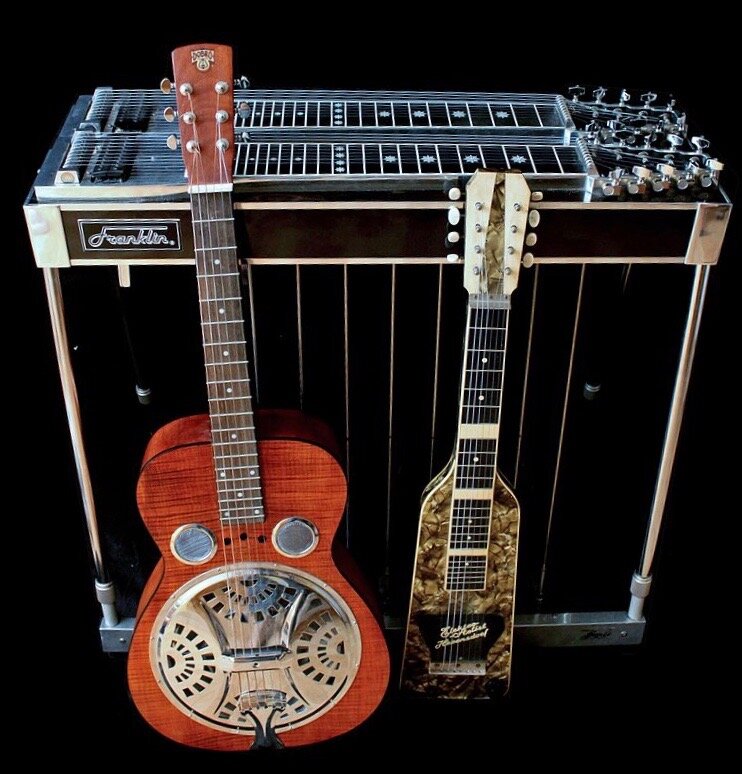By The Landlord
“You're just hanging this piece of glass on your hand. It's a really beautiful instrument in that it's so responsive, you're just slipping your hand back and forth.” — Bonnie Raitt
You can do it sitting down, standing up, or sideways, and especially if you close your eyes it’s smooth and, well, so undeniably sexy. But I confess, right here, I never used to like it. I always associated it exclusively with big-brimmed, hairy, overweight white men from the deep south, and in a stereotyped way, with some dubious history of race relations and a genre of music I could never quite enjoy – country. But of course I was wrong with that association, and something changed, especially over the past few years as my tastes spread, as they do, especially with the joys of the Song Bar to enrich your range, just as back in teen years, we’d swap records with school mates. And steel guitar, in its bigger definition, is also staple technique of the great black blues players and its sound is steeped in history. First though, let’s a have a listen to a beautiful rendition of a couple of classic songs on a Gibson Century 6 lap steel model, one orignally by Santo & Johnny, the other by Jerry Lordan:
So what exactly is steel guitar for it to feature in this topic, appearing in a song or instrumental in a prominent role? It’s any type of guitar played by moving a steel bar or similar object, such made of smooth glass, or maybe traditionally a beer bottle, or finger-filled tube made of metal, perspex, plastic or other material against the strings and frets. The movement technique is known as portamento, from the the Italian expression from the early 17th century, "portamento della voce" ("carriage of the voice”), bringing wonderful vibratos and smooth glissandos over wide intervals, including, almost exclusively, at least for acoustic instruments, the smooth carriage of entire chords rather than just single notes.
Steel guitar was first developed as a popular style in the 1890s by Hawaiian musician Joseph Kekuku. His type of playing is referred to as "lap steel" or "Hawaiian style”, because of where he held his guitar and it all began as a child when he picked up a bolt from a railway track and changed his strings. Here’s some background as told by his great niece …
But does the guitar have to be one type? Not at all. It’s all about technique. Here’s a traditional song on an old acoustic played by Frank Fairfield
So while sliding is less not seen so much on classical guitars, or standard acoustics or even many electric guitars, it could apply if the slide comes into play. But mostly steel guitar comes on three types of guitar - lap steel, pedal steel or resonator guitars, the latter especially have a very loud sound, square or round-necked, their volume increased by different systems, the Dobro-style spider, the biscuit, or the tricone. Part or completely metal, they are beautiful objects. "I was playing with steel picks on a steel guitar, and there was no amplification needed,” said American folk music and Piedmont blues singer Brownie McGhee.
A resonator is played in the traditional position with finger picks and a finger slide for flexibility
The lap steel meanwhile, played mainly across the knees, often does not have the traditional guitar body and with the strings above the frets. The Rickenbacker frying pan, an electric lap steel guitar produced from 1931 to 1939, was also first electric stringed instrument.
Hot sound. A Rickenbacker Frying Pan, made in 1931
Lap steel though is not just for old blues or country men. Larkin Poe is an American roots rock band hailing north Georgia fronted by sisters Rebecca Lovell and Megan Lovell. Their name derives from being direct descendants from the writer Edgar Allan Poe. Influenced by the Allman Brothers, they are both great singers with southern harmonies, heavy electric guitar riffs, and Megan on slide guitar. In a live setting Megan plays it standing up with a strap. Here’s she is talking about some techniques:
And here’s a sample of them playing together with Rebecca on a resonator:
Pedal steel, meanwhile, is a bigger model, set on legs, more of a 10-string electric console instrument with one, two or more necks set in different tunings to the traditional E-A-D-G-B-E, one being C-E-G-A-C-E as a rich C chord or C6, the other often in E, but also it can have up to 10 pedals and a separate volume pedal, and up to eight knee levers are used to alter the tunings of various strings, allowing more varied and complex music than any other type of steel guitar.
Big slider … a four necked pedal steel model
We have then, as usual, a host of other guitarists sliding into the bar to talk about this very subject.
While Megan Lovell tunes are lap steel to a sliding G chord, Warren Haynes of the Allman Brothers says: “I also generally play slide guitar in standard tuning, which enables me to switch back and forth between using the slide and fretting notes and chords conventionally without having to relearn the fretboard, as one must do when playing in an open tuning.”
On this tuning aspect, the British singer-songwriter Ken Hensley, who worked with Uriah Heep, admits: “I didn't know that you were supposed to tune the guitar to an open chord, and I learned to play slide with a normal tuning. I think it's a little more melodic that way and doesn't sound so bluesy. Of course, if I could play like David Lindley or Ry Cooder, I'd be a happy man!” Thanks Ken. Two great player recommendations for this topic to boot.
Any more hot slide tips? Junior Wells, the Chicago blues singer and harmonica player tells us: “I used to go and do some sitting in with Robert Nighthawk when he were playing at the 708 Club in Chicago. He was a tremendous slideman. I never saw him do anything other than play the slide. I never just saw him just use his hand. He always used a slide. He had a little-bitty drummer we called "Shorty". He was about that high [hand gesture]. And he was his drummer. That's all he had was a slide guitar and a drummer.”
Lap steel
Bob Whitlock, who played with Eric Clapton in Derek and the Dominoes bigs up Duane Allman. “He inspired the group to explore the extended jam format. Moreover, his ferocious slide playing motivated Clapton to turn in some of the finest guitar performances of his career.
Who else might be on the slide radar? Sonny Landreth? Steve Miller? George Harrison? Jimmy Page? Foghat’s Rod Price? Rory Gallagher? Johnny Winter? Derek Trucks? The great bluesman Elmore James? One thought and association just keeps sliding into another … the choices then are yours.
The great Elmore James, known as the king of slide
Now, sliding into the great Song Bar seat of knowledge and wisdom, I’m delighted to welcome back, slipping into perfect pitch and harmony, the keeper of the Marconium the marvellous Marco den Ouden! Place your songs where steel guitar, in any of its forms, plays a prominent role, for deadline at 11pm on Monday UK time (BST) for playlists published on Wednesday. Smooth!
New to comment? It is quick and easy. You just need to login to Disqus once. All is explained in About/FAQs ...
Fancy a turn behind the pumps at The Song Bar? Care to choose a playlist from songs nominated and write something about it? Then feel free to contact The Song Bar here, or try the usual email address. Also please follow us social media: Song Bar Twitter, Song Bar Facebook. Song Bar YouTube. Subscribe, follow and share.
Please make any donation to help keep Song Bar running:






